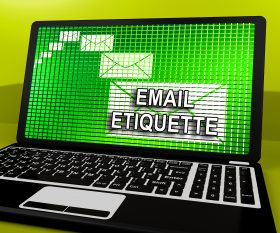Your grammar is a reflection of your image. Good or bad, you have made an impression. And like all impressions, you are in total control.
Jeffrey Gitomer
How do you use email etiquette to boost your performance and career? Your email etiquette defines you. It is your digital dress code. You may never before have met the person you are emailing but they will form a picture of you from the words, punctuation and grammar you use. Communications skills are now the second most sought after skill for the coming decade.
Good email etiquette implies good communications skills. Your aim should always be to convey the right message, right first time and in doing so a professional image of yourself. Punctuation, grammar and the correct use of the apostrophe is one way to achieve it. This saves everyone time and reduces the scope for misunderstanding and hence an email war.
A recent survey suggests that even in 2020, email is the preferred way to communicate in business and that there are still many words and phrases that business people really dislike such as:
Greetings: Hey; Happy XYX Day.
Sign-off: Kisses (xxx); Cheers.

Email etiquette to boost your performance
Phrases: Keeping you in the loop; As per my last email; Any update on this.
General: Caps; Slang and clichés; Too many exclamation marks; Emojis; Typos and spelling mistakes.
Here are ten top tips for writing emails which have stood the test of time and which will help you stand out in today’s crowded digital environment.
1. Focus the subject-line on exactly what the email is about and what action if any you need and by when.
2. Use the BLUF principle. Bottom line up Front, that is headline at the top then follow it with the detail. Very important when emailing top executives if you want to catch their eye.
3. Keep the content succinct focused on a single topic and use simple words.
4. Avoid clichés as they can make you appear unimaginative and careless. For example, ‘just keeping you in the loop’. Rather, tell the person why you have forwarded the email – eg ‘thought you might like to know the sales figures are up 5% which reflects our new product’.
5. Use a neutral tone and avoid any emotive words. For example, if you need to remind someone to read your email, be more assertive (rather than aggressive) with words like ‘see below’ and be specific about what needs their attention.
6. Avoid one word responses which can be open to misinterpretation such as ‘OK’. Does this mean OK I will do it now or OK stop nagging me? Instead reply properly saying by when you will do the task.
7. Use plain simple fonts and text. Leave colour, emojis etc to social media and text messages. Despite their proliferation not everyone understands emojis and about 4.5% of the population are colour blind most of whom are men.
8. Use a professional greeting and sign-off. Keep all the more informal and familiar ones for social media and text.
9.Always include your contact phone number in the sign-off (even if it’s the fifth iteration and you only put your name – add your phone number).
10. Before hitting send, check your grammar and spelling and especially homonyms (eg bat the bird and bat the implement used to hit a ball).
Email etiquette is something over which you have control. Use it wisely to create the image you want to convey of yourself and improve your own performance.
For more tips like these see
Tags: Boost your career, Boost your performance, business email etiquette, email etiquette
Great content! Super high-quality! Keep it up! 🙂